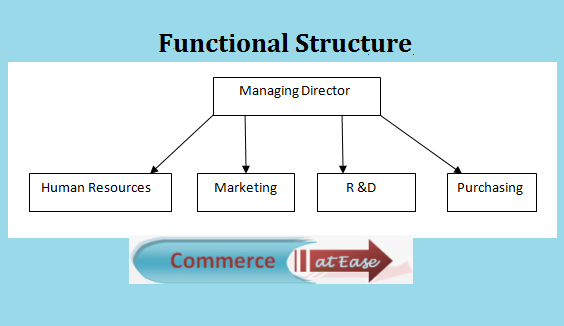Types of organization structures
- Functional structure
- Divisional structure
Functional structure
In functional structure jobs of similar nature are grouped and organized as separate departments on the basis of their functions.
Suitability:
- When the size of organization is large,
- Has diversified activities and
- Operations require a high degree of specialization.
Advantages of functional structure
- Leads to occupational specialization and promotes efficiency;
- Promotes control and coordination;
- Increase managerial and operational efficiency and results in increased profit;
- Leads to minimal duplication of efforts and results in economies of scale & lower cost;
- Makes training of employee easier;
- Ensures that different functions get due attention.
Disadvantages of functional structure
- Placesless emphasis on overall enterprise objectives than the objectives pursued by functional head.
- Lead toproblems in coordination as information has to exchange across different departments.
- Conflict of interestsarises when the interests of two or more departments are not compatible.
- Lead to inflexibility as people same skills and knowledge may develop narrow perspective.
Divisional structure
In this structure activities are grouped on the basis of products. This comprises of separate business units or divisions. Each unit has a divisional manager responsible for performance and who has authority over the unit.
Suitability
- For enterprises producing large variety of products;
- Organization grows and needs to add more employees;
- Create more departments.
Advantages of divisional structure
- Product specialization helps in development of various skills in divisional head and prepares him for higher positions.
- Divisional heads are accountable for profits, as revenues and costs related to different departments can be easily identified and assigned to them.
- It promotes flexibility and initiative because each division functions as an autonomous unit which leads to faster decision making.
- It facilitates expansion and growth as new divisions can be added without interrupting the existing operations by merely adding another divisional head and staff for the new product line.
Disadvantages of divisional structure
- Conflict may arise among different divisions with reference to allocation of funds and further a particular division may seek to maximize its profits at the cost of other divisions.
- It may lead to increase in costs since there may be a duplication of activities across product divisions with separate set of similar functions increases expenditure.
- It provides managers with the authority to supervise all activities related to a particular division. In course of time, such a manager may gain power and in a bid to assert his independence may ignore organizational interests.
Difference Between Functional Structure and Divisional Structure


